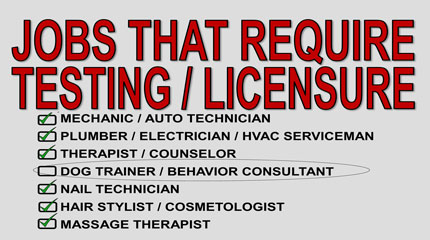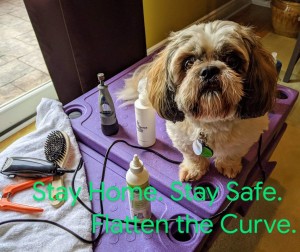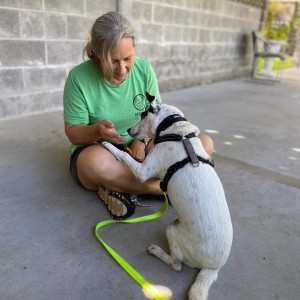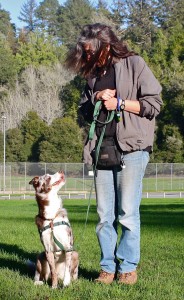The array of choices for choosing a dog trainer out there is staggering. Some trainers espouse one end of the training methodology spectrum, while others embrace the opposing philosophy. Without hours upon hours of research on the subject, at a superficial glance, there is just no good way for a dog parent to know who they should hire.
Choosing someone with a certification would seem the way to go, but wait, is the playing field level when the word certification is used by someone as their claim to a credential? Not even close! Certifying bodies (or individuals!) are all different and have widely ranging criteria. Add to that, the fact that literally anyone can say that they are certifying people as dog trainers and it is perfectly legal to do this. The word certified has been rendered meaningless in this field. With no single oversight organization regulating the body of knowledge required by dog trainers at any level, there is simply no way of knowing what each certification is required to achieve, if anything at all.
Don’t get me wrong. I strongly believe that those who want to be considered professionals in this field should make an effort to gain some baseline certification by a *respected* organization that has some minimum guidelines and a decent code of ethics. But many current certifications are just a baseline, not an end goal. Additionally, most quality professional organizations in this field prefer to remain open to all ends of the methodology spectrum in order to have a better chance educating the masses. You cannot educate properly if you judge too harshly and exclude those who may learn to move forward with their knowledge. I get that and I wholeheartedly agree with it. Change comes from within and without being judged. I started out as a traditional trainer. Without access to the APDT and their vast knowledge, I would not be where I am today. So while someone who has a reasonably well respected baseline certification has the knowledge that such a certification requires, that does not means all of those with that particular certification choose to utilize the same methodology or are at the same current level of knowledge. Confused yet?
Regulation is what this field desperately needs. I know that many of my colleagues are worried about this while many others support it. I am on the side of support. I firmly believe that science always wins so having the American Veterinary Society of Animal Behavior in charge of various levels of licensing is a no brainer for what I hope will be well regulated licensing for dog trainers and behavior consultants some day. After all, who gets to decide the various levels of knowledge required in other licensed fields? The experts! So why would anyone fear that those without top level educational credentials would get a crack at this? It would be highly unethical and ill advised to do otherwise.

Jobs that require testing — not dog training. Graphic courtesy Jim Fox.
Currently the only country to legislate dog training is Germany. They overwhelmingly require modern methods be used. There are testing requirements and licensing requirements for dog trainers. There are also testing requirements for dog PARENTS! I consider this a wonderful thing. The trainer requirements seem to vary a bit by district but what is all encompassing is that the country’s humane laws state that one cannot cause pain to a dog in order to train them. That fact does more to level the playing field in Germany than any “certification” in the USA that is currently available will ever do. One can purchase a prong, choke or shock collar in Germany but one cannot use them on one’s dog. There was a recent case where a couple was found guilty of cruelty because they did use a shock collar on their dog. I wish that would happen in the US soon! You can read more about the humane laws in this translated to English article from a few years ago. German humane laws.
Hillsborough County, in Florida has fairly recently passed some legislation that requires training plan transparency from dog trainers prior to being hired. They also must be licensed by the county. There are no restrictions on methods used but several people whose dogs have been injured by “trainers” using old fashioned methods during board and train decided enough was enough. They wanted there to be more information up front of what exactly might be done to their dog in the name of training. They felt that they could make better informed decisions on who to hire. I agree. A few local trainers who use modern methods joined their efforts. This is a good start. So many people just don’t realize what actually transpires during most board and trains. The quantity of professionals who utilize modern rewards-based methods with a board and train is low, unfortunately. So while methods are not restricted in any way, transparency of what a trainer might include in a training plan for a behavior that they are being hired to fix IS required. I would prefer that they not call it a training plan, as that would be unethical to offer prior to meeting a dog. But I am assured by those involved that it simply means what *might* be used to fix the behavior in question. Read about that here. Hillsborough County Florida Dog Training Transparency Law
Until there is regulation in this industry, how do you, as a dog parent, decide who does have the knowledge and certification that you are looking for, in order to spend both your money and your time wisely? Well, I will make a concentrated attempt to help you understand what all of the most well known “certifications” mean, as well as what you should view as a red flag. Grab a seat and a beverage as this won’t be a short article.
**Disclaimer: this article is about US based organizations only. Many of these groups are international but in some cases, the requirements are different in other countries. APDT is a good example of this. I am discussing US based membership requirements only here. **
APDT: The Association of Professional Dog Trainers or APDT for short, is not a certifying agency. Placing the initials APDT after your name will actually get you into trouble with the organization, as they don’t appreciate being misrepresented. If you pay your dues and click a box to be listed in the directory, then you are listed. It’s that simple. Qualified trainers as well as those who simply paid a fee to join or even those who paid a larger fee to have their listing highlighted, are all in the same listing. Larger fees get you listed first. Certifications that they recognize get you listed AND coming up in the certified only listing if the person searching chooses that option. Being listed does not imply one is qualified OR uses modern methods. The APDT offers a nice disclaimer stating just that. Reading the fine print will always be important.
UPDATE: APDT, CCPDT and IAABC have joined forces to create their shared Code of Ethics.
CCPDT: The Certification Council of Professional Dog Trainers is a certifying organization that originally was created by the APDT. They have been a separate organization for quite some time now. They offer several levels of certification, the most widely known is the CPDT-KA or Certified Professional Dog Trainer-Knowledge Assessed. This is a basic knowledge test that is a good starting point for those in the field. I like to think of it as an Associate Degree for dog trainers. Passing this written test means that the trainer in question has some book knowledge on varying subjects. There are requirements for client/class hours but they are minimal. There is also no real way to validate the submitted hours or what they actually apply to. Certified members are not required to adhere to a particular methodology, though there is a suggested code of ethics. As far as application of the book knowledge, there is no real way to determine that aside from thorough reading of the website for the trainer and/or asking for references. That said, it’s a good start. But again, read the fine print.
Another certification offered by this organization is more the advanced, CPDT-KSA, which stands for Certified Professional Dog Trainer-Knowledge Skills Assessed. This certification goes beyond a written test and requires video submissions. This is definitely a more thorough certification that just the KA.
Finally, the CCPDT also offers the CBCC-KA certification. This written test is more geared towards behavior modification rather than training. So this test is more intensive. Again, better than baseline is always going to be a good thing!
UPDATE: APDT, CCPDT and IAABC have joined forces to create their shared Code of Ethics.
IAABC: The International Association of Animal Behavior Consultants. This organization focuses more on behavior than strictly training manners. They also do not limit themselves to dogs. One can get certified in dog behavior, cat behavior, equine behavior, bird behavior and shelter animal behavior as well as service animals. The certification process is not easy and one should be proud of achieving the various certification options. I cannot say enough good things about this organization. The primary dog behavior certification is a CDBC, also known as a Certified Dog Behavior Consultant. This is the certification that I possess. One can also have an Associate Certification, which means that you are on the path to being certified. There is also an option to be a supporting member. This organization is meant to be an open educational organization so there are no limits to methodology. The organization does have a LIMA ethic, which means Least Intrusive, Minimally Aversive. This can be interpreted subjectively by some people. So again, research is your friend when choosing a consultant. I do consider this organization one of the highest quality organizations in existence in this field, with a strong emphasis on continuing education. This listing is my go to for finding a quality consultant for someone in need, outside of my area.
UPDATE: APDT, CCPDT and IAABC have joined forces to create their shared Code of Ethics.
PPG: The Pet Professional Guild. This is the only organization that requires the use of modern methodology in order to become a member. One needs to have a reference from an existing member to join. While requiring this might seem like a good thing to many, the simple fact that one uses modern methodology only does not indicate the quality of education that one possesses. They now offer 3 levels of certification. Some require video submissions. Unfortunately, I could not get enough information on the actual testing to offer an educated opinion. All I know is that at least one test is multiple choice, which is not my favorite testing method. Read more about PPG credentialing.
Online training schools: ABC (Animal Behavior College), Catch Canine Academy, Karen Pryer Academy, The Academy for Dog Trainers are the primary ones out there. ABC is mixed methods and no requirement for continuing education nor so proper code of ethics as far as conduct and methods used after graduation. Catch is modern methods and various levels of progression. From personal experience, I would far rather have a Catch student doing an externship than an ABC student. The quality of education is much better. That said, this is just a beginning point, not an ending point and the next step should be working for/with an experienced trainer and learning more before offering assistance to dog parents with just this “credential”. KPA and The Academy are more involved programs that offer much more intensive in person learning opportunities. KPA requires graduates to maintain CEU’s in order to keep their title. There are other training academies for those who wish to utilize more old-fashioned methods. They won’t be listed here so if you don’t recognize the name as one of these, skip their graduates for best results.
Mostly in person academies include Pat Miller’s (PMCT) and the Victoria Stilwell academy. Both are quality programs. Pat Miller’s certification has several levels that are very intensive and in person. VS Academy has a couple of levels in person as well as the in-between portions where the student works with their mentor hands on. VS graduates are just that, graduates. No certification is involved, which I love. All levels of knowledge go through this program. Pat Miller’s has certifications with stringent testing requirements. Victoria Stilwell also offers the VSPT designation that allows modern methodology trainers to use those initials after an extensive interviews, video submissions, and references with a minimum of 2 years of professional training under their belts. All three of these mentioned are quality options.
PetsMart, Petco, Camp Bow Wow all say that their trainers are certified (or in PetSmart’s case, accredited, a vastly inappropriate term more typical for museums and universities and not even close to the proper meaning of here see definition ). They all are, but internally by their own program. They all say that they utilize positive reinforcement but that phrase means different things to different people. For example, at least some Camp Bow Wows uses spray water bottles in baby puppy classes to “discipline” puppies. Not necessary and not positive at all! As of the time of this writing, PetsMart has a 2-week, 80 hour course and Petco has a 6-week course that became more intensive about a year ago and is in progress to further develop even more rigid requirements. They also appreciate being told about any store not adhering to their corporate standards and will immediately address it with the store in question. This is a good start for consumers who take Petco classes. But be mindful that your trainer could have been a cashier at the grocery store before that 2 to 6 week course. This is definitely not enough education to teach people how to train their dogs. That said, there are plenty of trainers who do continuing education on their own, and/or who opt to work for these companies to get to do the job that they love, while also having steady employment. Those trainers will advertise that fact. This is a good thing. Again, research and trust your instincts.
The only real certifications are Veterinary Behaviorists and Certified Applied Animal Behaviorists. These are board certified individuals with a doctorate level degree.
Then we have the really scary ones. There are dozens of individual certifications by people calling themselves qualified to offer such to anyone willing to pay the cost of a 6 week or so course either in person or online and “achieving” the title of “master trainer” or something similar, many of them franchises that require little or no dog training knowledge to start with. As a general rule, avoid any franchise that offers a guarantee. It is impossible to guarantee the future behavior of a sentient being. It’s a huge red flag when someone says that is possible. Also avoid corporate type “trainers” that operate under the umbrella of another “trainer” with an 800 number that then goes to whoever is their rep in the area. Again, this will always be a traditional methods based “trainer”.
That covers most of the letters or phrases that you might see in relation to so called certification. It’s just too confusing for the general dog parenting public. No one should have to become a dog trainer in order to understand who is safe to hire for assistance with their dog. This is clearly why overall regulation is the way to go, with the veterinary behaviorists at the helm. It is the only logical way to proceed as well as how all other vocations that need regulation proceed.
In addition to regulating trainers themselves to identify varying levels of expertise, we really need to start with regulating the meaning of the words so that it doesn’t take detective work to determine how the person using said word defines it. For example, it used to be simple. We just identified ourselves as positive trainers and that was that. Not so much anymore. Now anyone that uses any kind of kindness, whether it’s simply a matter of saying good boy even once, states that they use positive reinforcement. Then the modern trainers decided to call themselves force-free. Now the trainers who use old fashioned methods are trademarking this moniker and stating that using a shock collar (that they call “just a tap” or “based on tens unit technology”) or intimidation to “train” is force-free. Despite the true definition of the phrase, the dog training consumer cannot even trust words anymore. I have taken to calling myself a modern methodology trainer who uses mark and rewards-based methods without pain or intimidation. That is quite a mouthful but what else is left when words that should imply safety for your dog are high-jacked by those who are intent on luring you in with falsehoods?!
More red flag words/phrases include: pack leader, alpha, dominance, pack walk, control, balanced, correction, e-collar, vibration collar, stim collar, and to lesser degrees, leadership, commands and obedience. Most modern trainers know better than to use the word leadership on their websites as that word has been so misused by old fashioned “trainers”. There are plenty of modern trainers who still use the word obedience, and to a lesser degree, commands, so that one requires a closer look at the rest of a trainer’s website. But I yearn for the day when the word “leadership” means the same thing as a quality parent and the word “obedience” is never mentioned about a dog again. Words are important! Read about that here Outdated Dog Training Terms
Make no mistake. All dogs can have their training and behavior modification plans succeed using modern methods. There is never going to be a need to utilize old fashioned methods or outdated tools in order to achieve your goals for your dog. Dog parents should not have to fear for their dog’s safety with someone they hire to help their dog. It’s time that we bring this profession into modern times and level the playing field. Dogs deserve it as do their loving guardians. Be your dog’s voice. Demand quality education and modern methods for those who work with dog behavior.
Tags: behavior modification, certification, certified dog trainer, dog behavior assistance, dog behavior organization, dog trainer listings, dog training, dog training certification, dog training methods, dog training organizations, dog training regulation, dog training schools, finding a quality dog behavior professional, force free dog training, modern methods dog trainers, positive dog training, regulation
Posted in: Projects



















